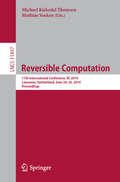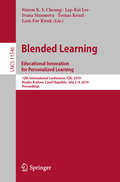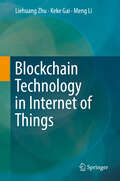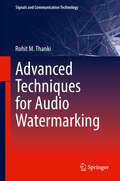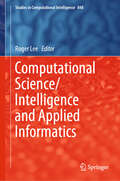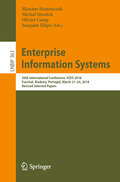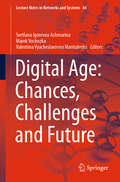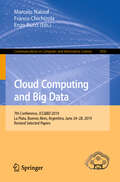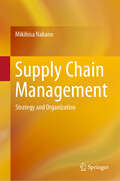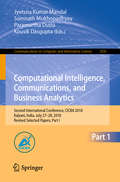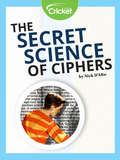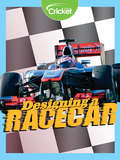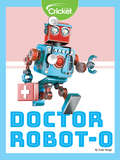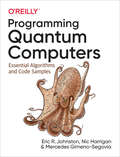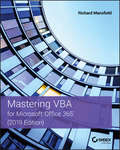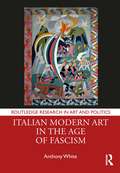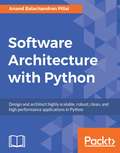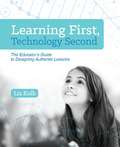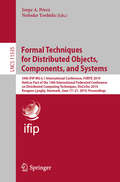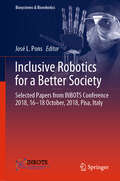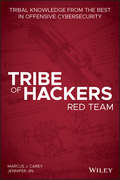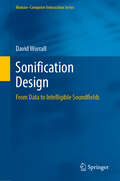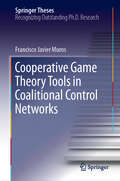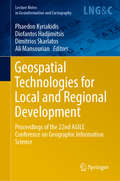- Table View
- List View
Reversible Computation: 11th International Conference, RC 2019, Lausanne, Switzerland, June 24–25, 2019, Proceedings (Lecture Notes in Computer Science #11497)
by Michael Kirkedal Thomsen Mathias SoekenThis book constitutes the refereed proceedings of the 11th International Conference on Reversible Computation, RC 2019, held in Lausanne, Switzerland, in June 2019.The 12 full papers and two short papers included in this volume were carefully reviewed and selected from 22 submissions. One invited talk is also included. The papers are organized in the following topical sections: theory and foundation; programming languages; circuit synthesis; evaluation of circuit synthesis; and applications and implementations.
Blended Learning: 12th International Conference, ICBL 2019, Hradec Kralove, Czech Republic, July 2–4, 2019, Proceedings (Lecture Notes in Computer Science #11546)
by Simon K. Cheung Lap-Kei Lee Ivana Simonova Tomas Kozel Lam-For KwokThis book constitutes the refereed proceedings of the 12th International Conference on Blended Learning, ICBL 2019, held in Hradec Kralove, Czech Republic, in July 2019. The 28 papers presented were carefully reviewed and selected from 80 submissions. The papers are organized in topical sections named: personalized and adaptive learning; content development for blended learning; experience in blended learning; analytics and evaluation for blended learning; open educational resources; and pedagogical and psychological issues.
Blockchain Technology in Internet of Things
by Liehuang Zhu Keke Gai Meng LiThis book focuses on picturing B-IoT techniques from a few perspectives, which are architecture, key technologies, security and privacy, service models and framework, practical use cases and more. Main contents of this book derive from most updated technical achievements or breakthroughs in the field. A number of representative IoT service offerings will be covered by this book, such as vehicular networks, document sharing system, and telehealth. Both theoretical and practical contents will be involved in this book in order to assist readers to have a comprehensive and deep understanding the mechanism of using blockchain for powering up IoT systems. The blockchain-enabled Internet of Things (B-IoT) is deemed to be a novel technical alternative that provides network-based services with additional functionalities, benefits, and implementations in terms of decentralization, immutability, and auditability. Towards the enhanced secure and privacy-preserving Internet of Things (IoT), this book introduces a few significant aspects of B-IoT, which includes fundamental knowledge of both blockchain and IoT, state-of-the-art reviews of B-IoT applications, crucial components in the B-IoT system and the model design, and future development potentials and trends.IoT technologies and services, e.g. cloud data storage technologies and vehicular services, play important roles in wireless technology developments. On the other side, blockchain technologies are being adopted in a variety of academic societies and professional realms due to its promising characteristics. It is observable that the research and development on integrating these two technologies will provide critical thinking and solid references for contemporary and future network-relevant solutions. This book targets researchers and advanced level students in computer science, who are focused on cryptography, cloud computing and internet of things, as well as electrical engineering students and researchers focused on vehicular networks and more. Professionals working in these fields will also find this book to be a valuable resource.
Advanced Techniques for Audio Watermarking (Signals and Communication Technology)
by Rohit M. ThankiThis book provides information on digital audio watermarking, its applications, and its evaluation for copyright protection of audio signals – both basic and advanced. The author covers various advanced digital audio watermarking algorithms that can be used for copyright protection of audio signals. These algorithms are implemented using hybridization of advanced signal processing transforms such as fast discrete curvelet transform (FDCuT), redundant discrete wavelet transform (RDWT), and another signal processing transform such as discrete cosine transform (DCT). In these algorithms, Arnold scrambling is used to enhance the security of the watermark logo. This book is divided in to three portions: basic audio watermarking and its classification, audio watermarking algorithms, and audio watermarking algorithms using advance signal transforms. The book also covers optimization based audio watermarking.Describes basic of digital audio watermarking and its applications, including evaluation parameters for digital audio watermarking algorithms;Provides audio watermarking algorithms using advanced signal transformations;Provides optimization based audio watermarking algorithms.
Computational Science/Intelligence and Applied Informatics (Studies in Computational Intelligence #848)
by Roger LeeThis book gathers the outcomes of the 6th ACIS International Conference on Computational Science/Intelligence & Applied Informatics (CSII 2019), which was held on May 29–31, 2019 in Honolulu, Hawaii. The aim of the conference was to bring together researchers and scientists, businesspeople and entrepreneurs, teachers, engineers, computer users, and students to discuss the various fields of computer science and to share their experiences and exchange new ideas and information in a meaningful way. Further, they presented research results on all aspects (theory, applications and tools) of computer and information science, and discussed the practical challenges encountered in their work and the solutions they adopted to overcome them. The book highlights the best papers from those accepted for presentation at the conference. They were chosen based on review scores submitted by members of the program committee and underwent further rigorous rounds of review. From this second round, 15 of the conference’s most promising papers were selected for this Springer (SCI) book and not the conference proceedings. We eagerly await the important contributions that we know these authors will make to the field of computer and information science.
Enterprise Information Systems: 20th International Conference, ICEIS 2018, Funchal, Madeira, Portugal, March 21-24, 2018, Revised Selected Papers (Lecture Notes in Business Information Processing #363)
by Slimane Hammoudi Michał Śmiałek Olivier Camp Joaquim FilipeThis book constitutes extended, revised and selected papers from the 20th International Conference on Enterprise Information Systems, ICEIS 2018, held in Funchal, Madeira, Portugal, in March 2018. The 19 papers presented in this volume were carefully reviewed and selected for inclusion in this book from a total of 242 submissions. They deal with topics such as data science and databases; ontologies; social networks; knowledge management; software development; human-computer interaction, and multimedia.
Digital Age: Chances, Challenges and Future (Lecture Notes in Networks and Systems #84)
by Svetlana Igorevna Ashmarina Marek Vochozka Valentina Vyacheslavovna MantulenkoThis proceedings book presents the outcomes of the VII International Scientific Conference “Digital Transformation of the Economy: Challenges, Trends, New Opportunities”, which took place in Samara, Russian Federation, on April 26–27, 2019. Organized by the Samara State University of Economics, the conference chiefly focused on digital economy issues, such as theoretical preconditions for the development of economic systems in the digital age and specific practical issues related to real-world business practice. Consisting of six chapters corresponding to the thematic areas of the conference, and written by scientists and practitioners from different regions of Russia, Kazakhstan, the Czech Republic and Germany, the book offers answers to the most pressing questions for today’s business community: - How is our world changing under the influence of digital technology? - Is sustainable economic development a myth or reality in the context of digitalization? - What threats and opportunities does digitalization bring? - What are realities and prospects of digitalization in the context of business practice? - How do we create a digital infrastructure for the economy? - How should the legal environment of the economy be transformed in the context of digitalization? The conclusions and recommendations presented are not recipes for solving the existing economic problems, but instead are intended for use in further research on transformation processes in the economy and in the development of state economic policies in various countries and regions.
Cloud Computing and Big Data: 7th Conference, JCC&BD 2019, La Plata, Buenos Aires, Argentina, June 24–28, 2019, Revised Selected Papers (Communications in Computer and Information Science #1050)
by Marcelo Naiouf Franco Chichizola Enzo RucciThis book constitutes the revised selected papers of the 7th International Conference on Cloud Computing and Big Data, JCC&BD 2019, held in La Plata, Buenos Aires, Argentina, in June 2019.The 12 full papers presented were carefully reviewed and selected from a total of 31 submissions. They are dealing with such topics as cloud computing and HPC; Big Data and data intelligence; mobile computing.
Supply Chain Management: Strategy and Organization
by Mikihisa NakanoThis book explains supply chain management (SCM) using the strategy–structure–process–performance (SSPP) framework. Utilizing this well-known framework of contingency theory in the areas of strategic management and organizational design, SCM is firmly positioned among management theories. The author specifically proposes a theoretical foundation of SCM that will be relevant to such areas as operations management, logistics management, purchasing management, and marketing. Both the static and dynamic sides of SCM are reported. On the static side, supply chain strategies are divided into three patterns: efficiency-oriented, responsiveness-oriented, and the hybrid efficiency- and responsiveness-oriented pattern. For each strategy, suitable internal and external supply chain structures and processes are proposed. On the dynamic side, the big issue is to overcome performance trade-offs. Based on theories of organizational change, process change, and dynamic capabilities, the book presents a model of supply chain process change. On structure, the focus is on the role of an SCM steering department. Illustrative cases are included from such diverse industries as automobiles (Toyota and Nissan ), personal computers (Fujitsu), office equipment (Ricoh), air-conditioning (Daikin), tobacco (Japan Tobacco), chemicals and cosmetics (Kao), and casual fashion (Fast Retailing and Inditex).The strategy and organization of SCM is systematically presented on the basis of the SSPP framework. In particular, the relationships among three management elements—strategy, structure, and process—can be identified in an SCM context. From many of the cases contained in this volume, there emerges an understanding of how to analyze the success and failure factors of SCM using the SSPP framework. In addition, the reader sees not only the static side SCM such as process operation but also its dynamic side such as process innovation and process improvement.
Computational Intelligence, Communications, and Business Analytics: Second International Conference, CICBA 2018, Kalyani, India, July 27–28, 2018, Revised Selected Papers, Part I (Communications in Computer and Information Science #1030)
by Paramartha Dutta Jyotsna Kumar Mandal Somnath Mukhopadhyay Kousik DasguptaThe two volume set CCIS 1030 and 1031 constitutes the refereed proceedings of the First International Conference on Computational Intelligence, Communications, and Business Analytics, CICBA 2018, held in Kalyani, India, in July 2018.The 76 revised full papers presented in the two volumes were carefully reviewed and selected from 240 submissions. The papers are organized in topical sections on computational intelligence; signal processing and communications; microelectronics, sensors, and intelligent networks; data science & advanced data analytics; intelligent data mining & data warehousing; and computational forensics (privacy and security).
The Secret Science of Ciphers
by Nick D'AltoEven if you aren't a spy, you probably already use cryptography, or the science of secret communication, every day.
Designing a Racecar
by Aaron MillarBefore the race even begins, engineers and designers have already been hard at work testing each and every part of a racecar.
Doctor Robot-O
by Lela NargiCan you imagine visiting a doctor's office for an illness or injury, but getting treated by a robot instead? According to some researchers, this could be the reality in the not too distant future. Ongoing research into artificial intelligence and its use in medicine might someday produce robots that will work alongside human doctors and nurses to deliver the best health care possible.
Programming Quantum Computers: Essential Algorithms and Code Samples
by Eric R. Johnston Nic Harrigan Mercedes Gimeno-SegoviaQuantum computers are set to kick-start a second computing revolution in an exciting and intriguing way. Learning to program a Quantum Processing Unit (QPU) is not only fun and exciting, but it's a way to get your foot in the door. Like learning any kind of programming, the best way to proceed is by getting your hands dirty and diving into code.This practical book uses publicly available quantum computing engines, clever notation, and a programmer’s mindset to get you started. You'll be able to build up the intuition, skills, and tools needed to start writing quantum programs and solve problems that you care about.
Mastering VBA for Microsoft Office 365 (Mastering Ser.)
by Richard MansfieldCustomize and ramp-up Office 365 applications The revised 2019 edition of Mastering VBA Microsoft Office 365 offers an accessible guide that shows how to extend the capabilities of Office 365 applications with VBA programming. Written in clear terms and understandable language, the book includes systematic tutorials and contains both intermediate and advanced content for experienced VB developers. Designed to be comprehensive, the book addresses not just one Office application, but the entire Office suite. To enhance understanding, the content is explored in real-world projects in Word, Excel, Outlook, and PowerPoint. Since the technical programming methods in the Office applications continue to evolve, the updated 2019 edition reviews the changes to the program. Code libraries, the API, and the object model for each Office program have been modified during the three years since the last version of this book. Various elements within VBA have been deprecated or replaced, and the surface UI changed as well. The updated 2019 edition covers topics such as: • Recording macros and getting started with VBA • Learning how to work with VBA • Using loops and functions • Using message boxes, input boxes, and dialog boxes • Creating effective code • XML-based files, ActiveX, the developer tab, content controls, add-ins, embedded macros, and security Written for all levels of Microsoft Office 365 users, Mastering VBA Microsoft Office 365: 2019 Edition explains how to customize and automate the Office suite of applications.
Italian Modern Art in the Age of Fascism (Routledge Research in Art and Politics)
by Anthony WhiteThis book examines the work of several modern artists, including Fortunato Depero, Scipione, and Mario Radice, who were working in Italy during the time of Benito Mussolini’s rise and fall. It provides a new history of the relationship between modern art and fascism. The study begins from the premise that Italian artists belonging to avant-garde art movements, such as futurism, expressionism, and abstraction, could produce works that were perfectly amenable to the ideologies of Mussolini’s regime. A particular focus of the book is the precise relationship between ideas of history and modernity encountered in the art and politics of the time and how compatible these truly were.
Software Architecture with Python
by Anand Balachandran PillaiArchitect and design highly scalable, robust, clean, and highly performant applications in Python About This Book • Identify design issues and make the necessary adjustments to achieve improved performance • Understand practical architectural quality attributes from the perspective of a practicing engineer and architect using Python • Gain knowledge of architectural principles and how they can be used to provide accountability and rationale for architectural decisions Who This Book Is For This book is for experienced Python developers who are aspiring to become the architects of enterprise-grade applications or software architects who would like to leverage Python to create effective blueprints of applications. What You Will Learn • Build programs with the right architectural attributes • Use Enterprise Architectural Patterns to solve scalable problems on the Web • Understand design patterns from a Python perspective • Optimize the performance testing tools in Python • Deploy code in remote environments or on the Cloud using Python • Secure architecture applications in Python In Detail This book starts off by explaining how Python fits into an application architecture. As you move along, you will understand the architecturally significant demands and how to determine them. Later, you'll get a complete understanding of the different architectural quality requirements that help an architect to build a product that satisfies business needs, such as maintainability/reusability, testability, scalability, performance, usability, and security. You will use various techniques such as incorporating DevOps, Continuous Integration, and more to make your application robust. You will understand when and when not to use object orientation in your applications. You will be able to think of the future and design applications that can scale proportionally to the growing business. The focus is on building the business logic based on the business process documentation and which frameworks are to be used when. We also cover some important patterns that are to be taken into account while solving design problems as well as those in relatively new domains such as the Cloud. This book will help you understand the ins and outs of Python so that you can make those critical design decisions that not just live up to but also surpass the expectations of your clients. Style and approach Filled with examples and use cases, this guide takes a no-nonsense approach to help you with everything it takes to become a successful software architect.
Learning First, Technology Second: The Educator's Guide to Designing Authentic Lessons
by Liz KolbLearning with technology does not happen because a specific tool “revolutionizes” education. It happens when proven teaching strategies intersect with technology tools, and yet it is not uncommon for teachers to use a tool because it is “fun” or because the developer promises it will help students learn. <p><p> Learning First, Technology Second offers teachers the professional learning they need to move from arbitrary uses of technology in their classrooms to thoughtful ways of adding value to student learning. <p> This book includes: an introduction to the Triple E Framework that helps teachers engage students in time-on-task learning, enhance learning experiences beyond traditional means and extend learning opportunities to bridge classroom learning with students’ everyday lives; effective strategies for using technology to create authentic learning experiences for their students; case studies to guide appropriate tech integration; and a lesson planning template to show teachers how to effectively frame technology choices and apply them in instruction.
Formal Techniques for Distributed Objects, Components, and Systems: 39th IFIP WG 6.1 International Conference, FORTE 2019, Held as Part of the 14th International Federated Conference on Distributed Computing Techniques, DisCoTec 2019, Kongens Lyngby, Denmark, June 17–21, 2019, Proceedings (Lecture Notes in Computer Science #11535)
by Jorge A. Pérez Nobuko YoshidaThis book constitutes the proceedings of the 39th IFIP WG 6.1 International Conference on Formal Techniques for Distributed Objects, Components, and Systems, FORTE 2019, held in Copenhagen, Denmark, in June 2019, as part of the 14th International Federated Conference on Distributed Computing Techniques, DisCoTec 2019. The 15 full and 3 short papers presented were carefully reviewed and selected from 42 submissions. The conference is dedicated to fundamental research on theory, models, tools, and applications for distributed systems.
Inclusive Robotics for a Better Society: Selected Papers from INBOTS Conference 2018, 16-18 October, 2018, Pisa, Italy (Biosystems & Biorobotics #25)
by José L. PonsThe book reports on advanced topics in interactive robotics research and practice; in particular, it addresses non-technical obstacles to the broadest uptake of these technologies. It focuses on new technologies that can physically and cognitively interact with humans, including neural interfaces, soft wearable robots, and sensor and actuator technologies; further, it discusses important regulatory challenges, including but not limited to business models, standardization, education and ethical–legal–socioeconomic issues. Gathering the outcomes of the 1st INBOTS Conference (INBOTS2018), held on October 16–20, 2018 in Pisa, Italy, the book addresses the needs of a broad audience of academics and professionals working in government and industry, as well as end users. In addition to providing readers with detailed information and a source of inspiration for new projects and collaborations, it discusses representative case studies highlighting practical challenges in the implementation of interactive robots in a number of fields, as well as solutions to improve communication between different stakeholders. By merging engineering, medical, ethical and political perspectives, the book offers a multidisciplinary, timely snapshot of interactive robotics.
A Creeper Camps Out: The Creeper Diaries, An Unofficial Minecrafters Novel, Book Eleven (The Creeper Diaries #11)
by Greyson MannGerald isn’t exactly thrilled when his parents send him to summer camp. Building shelters? Not really his thing. Gathering mushrooms? Thanks, but no thanks. Tracking wolves? Um . . . NO. <P><P>Gerald especially dreads Survival Night, when he and his friend Sam have to sleep outside in the woods. <P><P>When Gerald stumbles onto an abandoned woodland mansion, he thinks it’s the perfect place to spend Survival Night! But a rival camp of villagers has already claimed the mansion. <P><P>Can Gerald find the courage to stand up to them? He’s going to need ALL his survival skills to defend his discovery—and his good buddy Sam.
Tribe of Hackers Red Team: Tribal Knowledge from the Best in Offensive Cybersecurity
by Marcus J. Carey Jennifer JinWant Red Team offensive advice from the biggest cybersecurity names in the industry? Join our tribe.The Tribe of Hackers team is back with a new guide packed with insights from dozens of the world’s leading Red Team security specialists. With their deep knowledge of system vulnerabilities and innovative solutions for correcting security flaws, Red Team hackers are in high demand. Tribe of Hackers Red Team: Tribal Knowledge from the Best in Offensive Cybersecurity takes the valuable lessons and popular interview format from the original Tribe of Hackers and dives deeper into the world of Red Team security with expert perspectives on issues like penetration testing and ethical hacking. This unique guide includes inspiring interviews from influential security specialists, including David Kennedy, Rob Fuller, Jayson E. Street, and Georgia Weidman, who share their real-world learnings on everything from Red Team tools and tactics to careers and communication, presentation strategies, legal concerns, and more Learn what it takes to secure a Red Team job and to stand out from other candidates Discover how to hone your hacking skills while staying on the right side of the law Get tips for collaborating on documentation and reporting Explore ways to garner support from leadership on your security proposals Identify the most important control to prevent compromising your network Uncover the latest tools for Red Team offensive security Whether you’re new to Red Team security, an experienced practitioner, or ready to lead your own team, Tribe of Hackers Red Team has the real-world advice and practical guidance you need to advance your information security career and ready yourself for the Red Team offensive.
Sonification Design: From Data to Intelligible Soundfields (Human–Computer Interaction Series)
by David WorrallThe contemporary design practice known as data sonification allows us to experience information in data by listening. In doing so, we understand the source of the data in ways that support, and in some cases surpass, our ability to do so visually. In order to assist us in negotiating our environments, our senses have evolved differently. Our hearing affords us unparalleled temporal and locational precision. Biological survival has determined that the ears lead the eyes. For all moving creatures, in situations where sight is obscured, spatial auditory clarity plays a vital survival role in determining both from where the predator is approaching or to where the prey has escaped. So, when designing methods that enable listeners to extract information from data, both with and without visual support, different approaches are necessary. A scholarly yet approachable work by one of the recognized leaders in the field of auditory design, this book will - Lead you through some salient historical examples of how non-speech sounds have been used to inform and control people since ancient times. - Comprehensively summarize the contemporary practice of Data Sonification. - Provide a detailed overview of what information is and how our auditory perceptions can be used to enhance our knowledge of the source of data. - Show the importance of the dynamic relationships between hearing, cognitive load, comprehension, embodied knowledge and perceptual truth. - Discuss the role of aesthetics in the dynamic interplay between listenability and clarity. - Provide a mature software framework that supports the practice of data sonification design, together with a detailed discussion of some of the design principles used in various examples. David Worrall is an internationally recognized composer, sound artist and interdisciplinary researcher in the field of auditory design. He is Professor of Audio Arts and Acoustics at Columbia College Chicago and a former elected president of the International Community for Auditory Display (ICAD), the leading organization in the field since its inception over 25 years ago.Code and audio examples for this book are available athttps://github.com/david-worrall/springer/ Here is an excellent review of the book by Dr Gregory Kramer: “Worrall proceeds bravely through the trees and vines of philosophy, information theory, aesthetics, and other contributors to sonification design theory. It’s a feat. He nails all of this down with the specific implementation system he’s designed over many years, and applies his theories to specific problems. In a field of research still in its first half century and setting its bearings in a world where human perception has become a sideshow to machine learning, deep learning, and artificial intelligence, the roots David provides will serve well.” Dr Gregory Kramer is the founding figure in the emerging field of sonification, founded the International Conference on Auditory Display (ICAD) and editor of the first book in the field, "Auditory Display: Sonification, Audification and Auditory Interfaces" (Addison Wesley, 1994).
Cooperative Game Theory Tools in Coalitional Control Networks (Springer Theses)
by Francisco Javier MurosThis book analyzes coalitional control schemes by incorporating concepts of cooperative game theory into a distributed control framework. It considers a networked architecture where the nodes are the agents and the edges are their communication links and either the agents or the links are established as the players of cooperative games related to the cost function of the coalitional schemes. The book discusses various cooperative game theory tools that are used to measure/analyze the players’ features, impose constraints on them, provide alternative methods of game computation, detect critical players inside the control scheme, and perform system partitioning of large-scale systems, such as the Barcelona drinking water network, which is described in a case study.
Geospatial Technologies for Local and Regional Development: Proceedings of the 22nd AGILE Conference on Geographic Information Science (Lecture Notes in Geoinformation and Cartography)
by Ali Mansourian Phaedon Kyriakidis Diofantos Hadjimitsis Dimitrios SkarlatosThis book includes the full research papers accepted by the scientific programme committee for the 22nd AGILE Conference on Geographic Information Science, held in June 2019 at Cyprus University of Technology, Limassol, Cyprus. It is intended primarily for professionals and researchers in geographic information science, as well as those in related fields in which geoinformation application plays a significant role.
